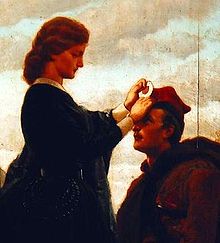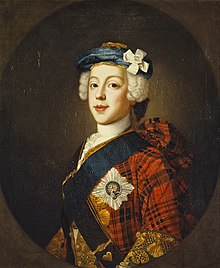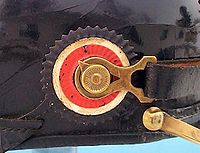Cockade



A cockade is a knot of ribbons, or other circular- or oval-shaped symbol of distinctive colours which is usually worn on a hat or cap.
The word cockade derives from the French cocarde, from Old French coquarde, feminine of coquard (vain, arrogant), from coc (cock), of imitative origin. The earliest documented use was in 1709.[1][2]
Eighteenth century


In the 18th and 19th centuries, coloured cockades were used in Europe to show the allegiance of their wearers to some political faction, or to show their rank or to indicate a servant's livery.[3][4] Because individual armies might wear a variety of differing regimental uniforms, cockades were used as an effective and economical means of national identification.[5]
A cockade was pinned on the side of a man's
In pre-revolutionary France, the cockade of the Bourbon dynasty was all white.[6][7][8] In the Kingdom of Great Britain supporters of a Jacobite restoration wore white cockades, while the recently established Hanoverian monarchy used a black cockade.[9][10][11][12] The Hanoverians also accorded the right to all German nobility to wear the black cockade in the United Kingdom.
During the 1780 Gordon Riots in London, the blue cockade became a symbol of anti-government feelings and was worn by most of the rioters.[13][14][15][16][17][18][19][20]
During the American Revolution, the Continental Army initially wore cockades of various colors as an ad hoc form of rank insignia, as General George Washington wrote:
As the Continental Army has unfortunately no uniforms, and consequently many inconveniences must arise from not being able to distinguish the commissioned officers from the privates, it is desired that some badge of distinction be immediately provided; for instance that the field officers may have red or pink colored cockades in their hats, the captains yellow or buff, and the
Before long however, the Continental Army reverted to wearing the black cockade they inherited from the British. Later, when
In the Storming of the Bastille, Camille Desmoulins initially encouraged the revolutionary crowd to wear green. This colour was later rejected as it was associated with the Count of Artois. Instead, revolutionaries would wear cockades with the traditional colours of the arms of Paris: red and blue. Later, the Bourbon white was added to this cockade, thus producing the original cockade of France.[26] Later, distinctive colours and styles of cockade would indicate the wearer's faction; although the meanings of the various styles were not entirely consistent, and they varied somewhat by region and period.
European military


From the 15th century, various
During the
The Second German Empire (1870–1918) used two cockades on each army headgear: one (black-white-red) for the empire; the other for one of the monarchies the empire was composed of, which had used their own colors long before. The only exceptions were the Kingdoms of Bavaria and Württemberg, having preserved the right to keep their own armed forces which were not integrated in the Imperial Army. Their only cockades were either white-blue-white (Bavaria) or black-red-black (Württemberg).[34][3][35]
The Weimar Republic (1919–1933) removed these, as they might promote separatism which would lead to the dissolution of the German nation-state into regional countries again.[36] When the
France began the first
Confederate States
Echoing their use when Americans rebelled against Britain, cockades – usually made with blue ribbons and worn on clothing or hats – were widespread tokens of
List of national cockades

Below is a list of national cockades (colors listed from center to ring):[42][43]
| Country and date |
Description | Image |
|---|---|---|
| red-black-red | ||
| sky blue-white-sky blue | ||
| orange-blue-red | ||
before 1918 |
black-gold | |
since 1918 |
red-white-red | |
| green-red-light blue | ||
| black-yellow-red | ||
(1825–1826) |
green-red-green (with a white 5 pointed star in the center) | |
(1826–1851) |
green-red-yellow | |
| green-yellow-red | ||
| blue-yellow-green | ||
| red-green-white | ||
| blue-white-red (with a white 5 pointed star in the blue portion) | ||
| yellow-blue-red | ||
| red-white-blue | ||
(1920–1993) |
blue-red-white | |
| blue-red-white | ||
(early 19th century) |
black | |
| red-white-red | ||
| red-blue-yellow | ||
(1922–1953) |
green-white-green | |
| black-white-red | ||
| white-black-blue | ||
(until 1936) |
green-yellow-red | |
| red-yellow-green | ||
| white-blue-white | ||
(1794–1814, 1815 and current since 1830) |
blue-white-red | |
(before 1794, 1814–1815 and 1815–1830) |
white | |
| green-yellow-light blue | ||
(1990–2004) |
black-white-wine red | |
(1848–1871) |
gold-red-black | |
| red-white-black | ||
(1956–1959) |
black-red-gold | |
| black-red-gold | ||
| green-yellow-red | ||
(1822) |
white-blue-white | |
(1833) |
blue-white | |
| blue-white | ||
| green-white-red | ||
| blue-white-red-white-blue | ||
| green-white-saffron | ||
| red-white-green | ||
(until 1922) |
green or sky blue | |
(since 1922) |
green-white-orange | |
(1861–1948) |
savoy blue | |
(since 1948) |
green-white-red | |
| red-white | ||
| green-white-red-white-black | ||
| carmine-white-carmine | ||
| red-green-yellow | ||
| green-white-red | ||
| white-red-white | ||
| orange | ||
| green-white-green | ||
| red-white-blue-white | ||
| white-green-yellow | ||
| blue-white-red | ||
| red-white-red | ||
(1898–1901) |
red-blue-silver | |
| red-white | ||
(1797–1820 and 1823–1830) |
blue-red | |
(1821–1823 and 1830–1910) |
blue-white | |
| green-red | ||
| blue-yellow-red | ||
(until 1917) |
black-orange-black-orange-white | |
| black-orange-black-orange | ||
| white-blue | ||
| red-blue-white | ||
Seychelles (1978–1996) |
green-white-red | |
| light blue-white-green | ||
| red-blue-white | ||
(until 1843 and 1844–1871) |
red | |
(1843–1844 and current since 1871) |
red-yellow-red | |
(military) |
yellow | |
(civilian) |
blue-yellow | |
| red-white-blue-white-red | ||
| green-red-white-blue | ||
| red-white-red | ||
| light blue-yellow | ||
| white (Stuart dynasty), black (Hanoverian dynasty), red-white-blue | ||
War of Independence )
|
black-white-black | |
(19th century) |
blue with an eagle in the centre | |
| white-blue-red | ||
(1828–1916) |
sky blue | |
(civilian) |
blue-white-blue-white-blue-white-blue-white | |
(military) |
blue-white-blue with a red diagonal line | |
(police) |
red-white-blue | |
| red-blue-yellow | ||
| blue-white-red |
Component states of the German Empire (1871–1918)

The German Empire had, besides the national cockade, also cockades for several of its states,[44] seen in the following table:
| State | Description |
|---|---|
| Anhalt | green |
| Baden | yellow-red-yellow |
| Bavaria | white-sky blue-white |
| Brunswick | blue-yellow-blue |
| Hanseatic cities (Bremen, Hamburg, Lübeck) | white with a red cross |
| Hesse | white-red-white-red-white |
| Lippe | yellow-red-yellow |
| Mecklenburg-Schwerin and -Streliz | red-yellow-blue |
| Oldenburg | blue-red-blue |
| Prussia | black-white-black |
| Reuss-Gera and -Greiz | black-red-yellow |
| Saxe-Altenburg, -Coburg and Gotha and -Meiningen | green-white-green |
| Saxe-Weimar | black-yellow-green |
| Saxony | white-green-white |
| Schaumburg-Lippe | blue-red-white |
| Schwarzburg-Rudolstadt | blue-white-blue |
| Schwarzburg-Sonderhausen | white-blue-white |
| Waldeck | black-red-yellow |
| Württemberg | black-red-black |
See also
References
- ^ "Cockade".
- ^ "The American Heritage Dictionary entry: Cockade".
- ^ ISBN 9781137277145. Retrieved 2017-03-05.
- ISBN 9780812200478. Retrieved 2017-03-05.
- ISBN 0-214-65349-8.
- ^ The White Cockade; Or, Bourbon Songster: Being a Patriotic Collection of Songs on the Downfall of Tyranny, and Restoration of Louis XVIII., Etc. [A Chap-book.]. J. Evans & Son. 1814. p. 2. Retrieved 2017-03-05.
- ^ Cobbett, W. (1814). Cobbett's Political Register. Vol. 25. William Cobbett. Retrieved 2017-03-05.
- ISBN 9780141941912. Retrieved 2017-03-05.
- ISBN 9780521893756. Retrieved 2017-03-05.
- ISBN 9781780965178. Retrieved 2017-03-05.
- ^ Jones, G.M. (1827). Travels in Norway, Sweden, Finland, Russia and Turkey: also on the coasts of the sea of Azof and of the Black sea; with a review of the trade in those seas, and of the systems adopted to man the fleets of the different powers of Europe, compared with that of England. J. Murray. p. 22. Retrieved 2017-03-05.
- ISBN 9781848846906. Retrieved 2017-03-05.
- ISBN 9781317397717. Retrieved 2017-03-05.
- ^ Stockdale, J.J. (1810). The Covent Garden Journal ... J.J. Stockdale. p. 130. Retrieved 2017-03-05.
- ISBN 9780226487175. Retrieved 2017-03-05.
- ^ Popular educator (1767). The popular educator. p. 254. Retrieved 2017-03-05.
- ]
- ISBN 9781460404256. Retrieved 2017-03-05.
- ^ CLIFFORD, H.; Brandon, J. (1809). Clifford for ever! O.P. and no P.B. The Trial between H. Clifford, plaintiff, and J. Brandon, defendant, for an assault and false imprisonment, etc. John Fairburn. p. 19. Retrieved 2017-03-05.
- ISBN 9780521195423. Retrieved 2017-03-05.
- ^ "Defense.gov News Article: Insignia: The Way You Tell Who's Who in the Military". archive.defense.gov. Archived from the original on 2018-01-23. Retrieved 2017-03-05.
- ISBN 9785885286961. Retrieved 2017-03-05.
- ISBN 9781782009214. Retrieved 2017-03-05.
- ISBN 9781101177211. Retrieved 2017-03-05.
- ISBN 9780393240573. Retrieved 2017-03-05.
- ^ ISBN 9781137277145. Retrieved 2017-03-05.
- ISBN 9780807899298. Retrieved 2017-03-05.
- ^ ADYE, R.W. (1802). The Little Bombardier, and Pocket Gunner. By Ralph Willett Adye. T. Egerton. p. 271. Retrieved 2017-03-05.
- ISBN 9780811705196. Retrieved 2017-03-05.
- ISBN 9781844862924. Retrieved 2017-03-05.
- ISBN 9781291187441. Retrieved 2017-03-05.
- ISBN 0-214-65349-8.
- ISBN 9781853674884. Retrieved 2017-03-05.
- ISBN 978-1-291-18744-1.
- ISBN 9781598849813. Retrieved 2017-03-05.
- ISBN 9781780967905. Retrieved 2017-03-05.
- ISBN 9781780961651. Retrieved 2017-03-05.
- ISBN 9780275948627. Retrieved 2017-03-05.
- ISBN 9781134089086. Retrieved 2017-03-05.
- ISBN 9783643905154. Retrieved 2017-03-05.
- ^ Goodheart, Adam (November 15, 2010). "Female Partisans" (blog). The New York Times. Retrieved October 14, 2022.
- ^ "Tableau comparatif de la superficie, population totale et pop. par m. géogr. de tous les Etats du monde, avec les cocardes et pavillons les plus connus / dressé d'après Malte-Brun, Hassel, Balbi et autres sources authentiques par C. Desjardins ; A. Haas, script" (in French). Gallica. 1833. Retrieved 2017-03-05 – via gallica.bnf.fr.
- ^ "Tableau comparatif de la superficie et de la population absolue et relative de tous les Etats du monde avec leurs pavillons et cocardes / dressé d'après les documens les plus récens par Ct. Desjardins,... ; Lith. de Mantoux,..." (in French). Gallica. 1842. Retrieved 2017-03-05 – via gallica.bnf.fr.
- ^ Hein. Das kleine Buch vom Deutschen Heere 1901.
Further reading
External links
 Media related to Cockades at Wikimedia Commons
Media related to Cockades at Wikimedia Commons
